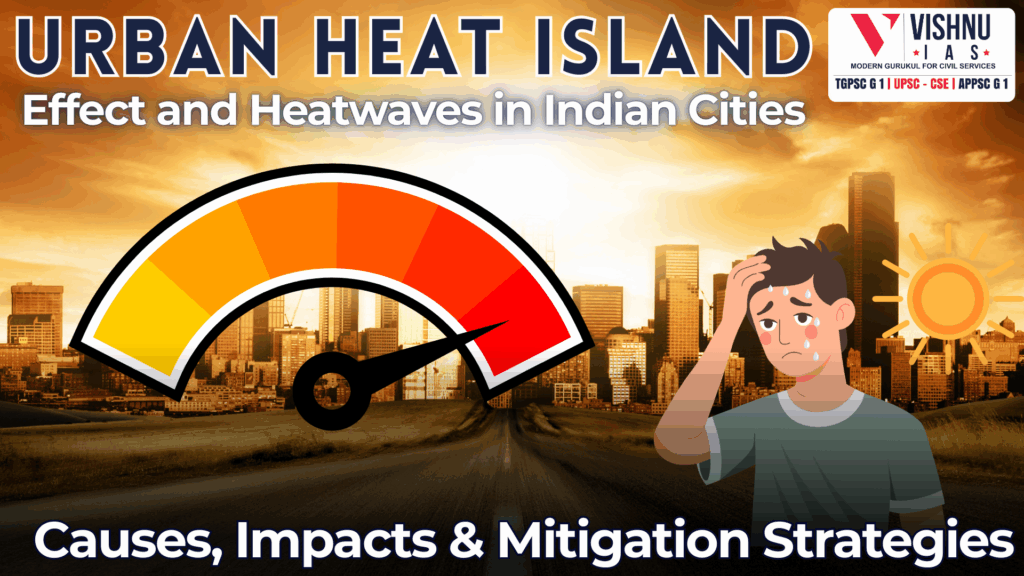Introduction:
- The Urban Heat Island (UHI) effect refers to the phenomenon where urban areas experience significantly higher temperatures than their surrounding rural regions. This is primarily due to factors such as dense infrastructure, reduced vegetation, and human activities. In India, the UHI effect has been intensifying, with studies indicating that urban areas can be
up to 2.0 to 10.3°C warmer than their rural counterparts, especially during nighttime. - The World Meteorological Organization reported that 2024 was the warmest year on record, with global temperatures approximately 1.55°C above pre-industrial levels. In India, the frequency and intensity of heatwaves have been rising over the past two decades, exacerbated by rapid urbanization and the UHI effect.
Body:
Causes of Urban Heat Island Effect in Indian Cities
Urbanization and Land Use Changes
- Rapid urban expansion leads to the replacement of natural landscapes with concrete and asphalt, which absorb and retain heat.
- Reduction in green spaces and water bodies diminishes natural cooling mechanisms.
- Example: Delhi’s transformation into a “heat trap” due to unbalanced urban growth and decreased wetlands
Building Materials and Architectural Designs
- Use of heat-absorbing materials like concrete and glass in modern constructions increases heat retention.
- Adoption of Western architectural styles unsuitable for India’s climate exacerbates indoor heat.
- Example: Traditional Indian designs with courtyards and ventilated spaces offer better thermal comfort.
Anthropogenic Heat Emissions
- Increased use of air conditioning units and vehicles releases additional heat into the environment.
- Industrial activities contribute to localized warming.
- Example: High energy consumption in cities like Mumbai and Delhi during summer months.
Reduced Vegetation and Green Cover
- Deforestation and lack of urban greenery limit shade and evapotranspiration.
- Example: Cities with more green spaces, like Bengaluru, experience relatively lower UHI effects compared to cities with sparse vegetation.
Impacts of UHI on Heatwaves in Indian Cities
- Increased Frequency and Intensity of Heatwaves Urban areas experience prolonged and more intense heatwaves due to UHI.
- Example: Delhi recorded temperatures exceeding 52°C, prompting severe heatwave alerts
Health Implications
- Higher temperatures lead to increased cases of heatstroke, dehydration, and other heat-related illnesses.
- Vulnerable populations, including the elderly and outdoor workers, are at greater risk.
- Example: Ahmedabad’s 2010 heatwave resulted in over 1,300 deaths, leading to the development of a Heat Action Plan
Economic Consequences
- Reduced labour productivity, especially in sectors like construction and agriculture.
- Increased energy consumption for cooling leads to higher electricity bills and potential power outages.
- Example: Heat stress in India resulted in an estimated 6% loss of work hours in 2023.
Environmental Degradation
- Elevated temperatures can alter local climates, affecting rainfall patterns and biodiversity.
- Example: UHI effects contribute to changes in spatiotemporal rainfall patterns in urban areas.
Mitigation Strategies and Government Initiatives
- Development of Heat Action Plans (HAPs) Cities like Ahmedabad have implemented HAPs focusing on early warning systems, public awareness, and healthcare preparedness.
- Over 23 Indian states and around 140 cities have developed state and city-level HAPs.
- Example: Ahmedabad’s HAP reduced heatwave-linked deaths by up to 25%.
Urban Greening and Infrastructure Projects
- Under the Atal Mission for Rejuvenation and Urban Transformation (AMRUT), 2,429 park projects worth ₹5,044.28 crore have been
- developed, adding 5,044 acres of green spaces.
- Initiatives to rejuvenate water bodies and increase urban greenery help mitigate UHI effects.
Promotion of Climate-Responsive Architecture
Encouraging the use of traditional building designs that enhance natural ventilation and reduce heat absorption.
Example: Revival of vernacular architecture in cities like Jaipur to combat UHI effects.
Policy and Financial Support
Schemes like the Pradhan Mantri Awas Yojana – Urban aim to build green and heat-resilient homes.
Alignment of HAPs with existing government programs can unlock funding for heat resilience initiatives.
Conclusion:
The Urban Heat Island effect significantly intensifies heatwaves in Indian cities, posing challenges to public health, economic productivity, and environmental sustainability. However, with proactive measures such as the development of Heat Action Plans, urban greening projects,
promotion of climate-responsive architecture, and supportive policies, it is possible to mitigate these effects.
A collaborative approach involving government agencies, urban planners, and communities is essential to build resilient cities capable of withstanding the increasing threats of heatwaves.


